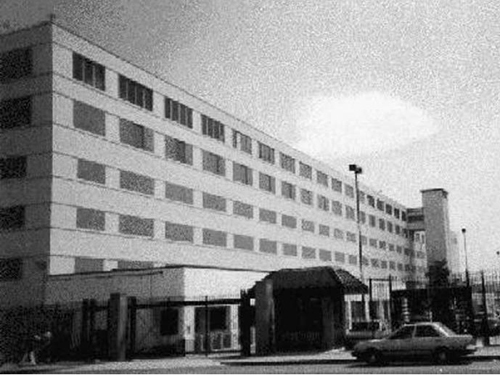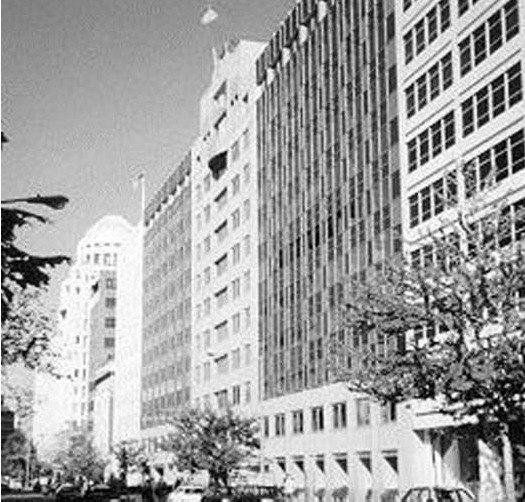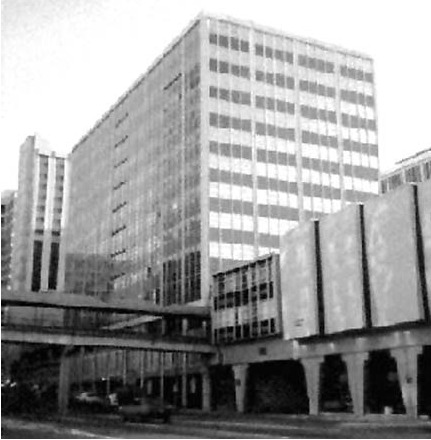The Wizards of Langley (24 page)
Read The Wizards of Langley Online
Authors: Jeffrey T Richelson


Headquarters of the National Photographic Interpretation Center at the Washington Navy Yard. NPIC was established in 1961 as “service of common concern” to be managed by the
CIA. In 1973, it became part of the DS&T. In 1995, it was merged with a number of other
agencies to form the National Imagery and Mapping Agency, which was placed within the
Department of Defense.
CREDIT
: Federation of American Scientists

(above) The Matomic Building (second from right) at 1717 H Street N.W. served as headquarters
for the U–2 project staff from February 1956 until March 1962, when the staff
moved to CIA’s new headquarters at Langley, Virginia.
CREDIT
: Federation of American
Scientists

(below) The Ames Building in Rosslyn, Virginia, housed a number of CIA offices for several
years, including the DS&T’s Office of Research and Development. The CIA moved
out of the facility in the late 1990s.
CREDIT
: Federation of American Scientists
*Thirty-five years later, Levison wondered “What the hell difference did it make?” and noted that the amount of film a satellite could carry in the case of CORONA, had increased from 20 to 180 pounds. With that much film on board, the sensible reaction to wasting a few frames of film would be “Who cares?” (Telephone interview with Walter Levison, September 17, 1999.)
CHANGE OF COMMAND
When Bud Wheelon headed back to California in October 1966 to become vice-president for engineering at Hughes Aircraft, he brought along the Distinguished Intelligence Medal awarded to him shortly before his departure.
1
He left behind a science and technology directorate that had become a key player in scientific and technical intelligence production, signals intelligence collection, and, most important, overhead reconnaissance.
In many ways, the DS&T was an intelligence community in itself—establishing requirements, developing and operating collection systems, and analyzing some of the data collected. What Ray Cline had seen as a problem—collectors and analysts reporting to the same boss—many in the directorate saw as a virtue. The priorities of those developing and operating collection systems flowed, without bureaucratic obstacles, from the priorities of the analysts.
Assuming command of the directorate, as acting deputy director, was former FMSAC chief Carl Duckett, who had become Associate Deputy Director for Science and Technology in mid-May 1966.
2
In some ways, Duckett was no Wheelon; in others, Wheelon was no Duckett.
Although the directorate would relinquish its role in aerial reconnaissance operations to the Air Force on his watch, Duckett’s strengths enabled the directorate to flourish and to reach its peak of power and influence. During his decade-long tenure, the objectives of the HEXAGON and RHYOLITE programs would be realized, another battle with the Air Force over development of an advanced satellite system would be fought and won, and collection operations in Iran and Norway would continue to yield vital intelligence on Soviet missile programs. The directorate would also expand its role in the CIA’s scientific and technical projects, assuming control over offices previously belonging to the intelligence and operations directorates.
In contrast to Bud Wheelon, who had arrived at the agency with advanced degrees from prestigious institutions and a long list of scientific publications, Carl Duckett brought no impressive scholarly credentials to the job, not even a college degree. The lack of such credentials almost prevented Duckett from becoming Wheelon’s successor.
Wheelon himself did not think Duckett should succeed him, despite his having “many fine qualities”—and told Raborn and Helms so. Wheelon believed that the directorate was still in the “creation” stage, that it needed a strong technical person, but that individuals such as Leslie Dirks were too young. Thus, he had lined up his former boss at TRW, Frank Lehan, to replace him. Lehan was familiar with DS&T operations, having served as a key adviser from its birth. But a personal problem, in the form of a wayward daughter, forced Lehan to withdraw his name after Wheelon made it clear he could not stay on for another year.
3
Wheelon informed Helms and possibly suggested another of the directorate’s key advisers—William Perry—for the job. But in April 1967, after more than six months of trying and failing to recruit someone with the appropriate scientific credentials and finding himself satisfied with Duckett, Richard Helms, Director of Central Intelligence since June 1966, removed the “Acting” from Duckett’s title.
4
Duckett lacked an academic background but he had other capabilities that proved of great value to a man in his position. He was, as former Deputy Director for Intelligence Edward Proctor observed, a good briefer, a man who, according to Dino Brugioni, “could turn technical data into laymanese.”
5
Such a talent was of great use in marketing, in selling senators and congressmen, many of whom had little or no understanding of technical issues, on the need for a new collection system. Indeed, Duckett was, according to one directorate official, “probably the best marketeer,” a man who “could sell Congress anything.”
6
Also crucial to Duckett’s ability to sell programs was his personal style. His experience as a disk jockey had made him a “smooth talker” who “had congressmen in the palm of his hand.”
7
His smooth talk was aided by his knowledge of the lives and families of key members of the Appropriations and Armed Services committees—who in the 1960s and early 1970s determined which CIA programs would be funded and which would not. His prehearing chats with legislators were often sufficient to ensure that military arguments in opposition to a CIA program fell on deaf ears.
8
On February 24, 1968, a Soviet Golf-II submarine, one of a class of diesel submarines armed with SS-N-5 Serb nuclear ballistic missiles, left port. Sometime in early March, while on a routine patrol that had taken it about 750 miles northwest of Hawaii, it surfaced to recharge its batteries, air out the crude ventilation system, and communicate with fleet headquarters at Vladivostok. Instead, the submarine imploded and sank in water three miles deep. Taken down with the submarine were its seventy-man crew, three SS-N-5 missiles, each tipped with a four-megaton warhead, and cipher material.
9
After twenty-four hours of listening in vain to the assigned frequency, the Soviet Pacific Fleet declared an emergency and began to hunt for the missing sub. A dozen ships, including four or five submarines, took part in the search. The first ships to arrive in the search area were greeted by heavy snowfall, gale winds, and waves forty-five feet high. The surface ships and submarines directed their sonar at the ocean below; the subs also dived to look for the missing sub.
10
Monitoring of the Soviet effort, as well as examination of earlier intercepted communications, led U.S. intelligence analysts to conclude that the sub was lost and that the Soviet navy had no solid idea where it sank. The U.S. Navy, on the other hand, had at least the rough coordinates for the site. That information came from the Navy’s Sound Surveillance System (SOSUS), a network of over twenty underwater hydrophone arrays that could pick up the sound generated by a variety of underwater activities—including that of submarines. The acoustic signals gathered by SOSUS could be used not only to distinguish among different submarine classes but also among individual subs in the same class. Analysis of the signals from the SEA SPIDER array, near Hawaii, yielded the conclusion that the sub’s most likely resting place was 1,700 miles northwest of Hawaii, at 40 degrees latitude and 180 degrees longitude.
11
Captain James F. Bradley Jr., who headed the Office of Naval Intelligence’s undersea warfare office, brought the news of the missing Soviet submarine to senior Navy officials, who then proposed to Secretary of the Navy Paul Nitze that the USS
Halibut
be assigned to search for the sub. Ultimately, the United States might be able to recover its missiles, code-books, and technological information.
12
The
Halibut
had been converted from a guided missile submarine to a “spy sub” under the direction of John P. Craven, the first director of the Navy’s Deep Submergence Systems Project. The Brooklyn native, whose
credentials included a doctorate in mechanical engineering and service as chief scientist in the Navy’s Polaris missile program, had modified the sub so that it could dangle cameras to view the ocean bottom as it hovered below the surface. What he had hoped to find, as part of an operation code-named SAND DOLLAR, were the warheads the Soviets left behind after missile tests in the Pacific.
13
During summer 1968, the
Halibut
lowered its thick cable toward the ocean floor, the attached lights and cameras searching for the sub. The resulting pictures showed the submarine’s sail, the three missile tubes, one of which was intact, and a sailor’s skeleton. The photos also showed that the lost submarine had broken into pieces. The rear engineering section had split off from the forward and central sections, which were about 200 feet in length and carried the ship’s three missiles.
14
In early September, the
Halibut
returned with a set of 22,000 photographs of the lost submarine, which were code-named VELVET FIST. Craven later told Congress, in secret testimony, that the “
Halibut
was able to locate, examine, and evaluate the accident and to obtain significant intelligence information concerning the submarine, its mission, and its equipments.”
15
But both the Navy and CIA wanted more than pictures—at the very least, the warheads and cipher material. Examination of the warheads would provide the United States with insight into the state of Soviet nuclear technology—particularly the reliability, accuracy, and detonation mechanisms of the missiles. Equally prized were the cipher machines and code manuals that might be stored in watertight safes.
16
Other possible items for recovery included the torpedoes, which if recovered would give U.S. analysts their first look at the Soviet devices. Data concerning the homing devices incorporated into the torpedo design would be of aid in developing countermeasures. And there was the submarine itself. Analysts could subject the steel used in the hulls to metallurgical analysis and possibly determine how deep Soviet subs could dive.
17
The prospect of recovering significant material produced two proposals—one Navy, one CIA. Bradley and Craven suggested sending mini-subs to grab a nuclear warhead, the safe containing the crypto codes, and the submarine’s burst transmitters and receivers. They considered it unnecessary to recover the missiles, which were primitive, and the submarine hull.
18
After listening to Bradley and Craven’s idea, Duckett and other CIA officials came back with a much more dramatic plan—to recover the for
ward and central sections of the submarine. According to one account, Bradley and Craven thought they were crazy. And when Duckett proposed mounting a recovery effort to DCI Richard Helms, his first response was “You must be crazy.” But, after further consideration, Helms approved Duckett’s idea.
19
With approval from the White House, the CIA contacted eccentric multimillionaire Howard Hughes, whose organization had a passion for secrecy. Hughes, along with its subcontractors, would spend over three years working on the first phase of what was then known as Project AZORIAN. They produced the
Glomar Explorer
—36,000 tons, 618 feet in length, and 115.5 feet in the beam—to serve as a floating, highly stable platform. In the center of the ship, a high derrick passed piping directly through the “moon pool” in the ship’s hull—a pool 200 feet long and 65 feet wide. The pool could be opened to allow an object to be lifted into it from the sea. A companion to the ship was a huge submersible barge, the
Hughes
Marine Barge-1
(
HMB-1
), roughly the size of a football field, that was covered by an oval roof and lowered below the
Glomar Explorer
. The barge carried gigantic retrieval claws that could embrace the submarine and raise it from its watery grave. The roof prevented Soviet reconnaissance satellites from photographing the cargo.
20
The loss of the Golf-II submarine, in addition to serving as the catalyst for AZORIAN, also led to the creation of a new reconnaissance office in which Duckett and the DS&T played a key role. The National Underwater Reconnaissance Office (NURO) was established in 1969 to serve as an underwater NRO, coordinating CIA and Navy efforts in underwater reconnaissance operations that included not only AZORIAN but also submarine reconnaissance missions, which often involved covert entry into Soviet ports. The office was headed by the Secretary of the Navy, at the time John Warner, the future senator from Virginia. Bradley served as NURO’s first staff director, and Duckett as the senior CIA representative to the new office.
21
At the time NURO was formed, completion of the AZORIAN mission was several years away.
Shortly before Bud Wheelon departed, the Office of Special Activities had also undergone a change of command. In August 1966, a month after Jack Ledford returned to regular Air Force duty, Brig. Gen. Paul Bacalis became the new head of the CIA’s aerial reconnaissance effort. Bacalis,
who had flown fifty combat missions as a B-24 pilot during World War II, had spent the two previous years at SAC headquarters, in the Inspector General’s office and the operations directorate.
22
As with Ledford, the job came as a surprise to Bacalis. In mid-1966, he was on the promotion list for brigadier general when he received a message to report to the Pentagon, where he discovered he had a job interview over at the CIA. Once there, he spent the entire day being interviewed by Wheelon, Duckett, Ledford, and Raborn. After three weeks passed, during which time other candidates were also interviewed, Bacalis was told his new assignment was as chief of OSA. Rather than the desk job he expected, he had his “own little Air Force.”
23
That “little Air Force” included the U-2s as well as the A-12s produced by the OXCART program. At the time Bacalis became OSA chief, the agency’s U-2 fleet had dwindled to six. However, on August 1, 1966, Mc-Namara and Helms had decided to order eight upgraded U-2s from Lockheed on behalf of the CIA and Air Force, and in November, they tacked on another four aircraft to their order. Of the total, six eventually went to the CIA.
24
Of course, while Lockheed worked on producing the new planes, the Nationalist Chinese pilots of Detachment H continued flying the old ones on an assortment of missions. On November 26, 1966, a mission planned to cover twenty-three targets selected by the interagency Committee on Overhead Reconnaissance (COMOR) penetrated the Chinese mainland at 69,000 feet, southeast of Luchiao Airfield. Before the mission was aborted due to an overheated light, the U-2 photographed twenty of the COMOR targets plus another forty of interest to the intelligence community. Coverage was obtained of Chungan Airfield, and a number of KOMAR missile patrol boats were detected at the Santu Naval Base.
25